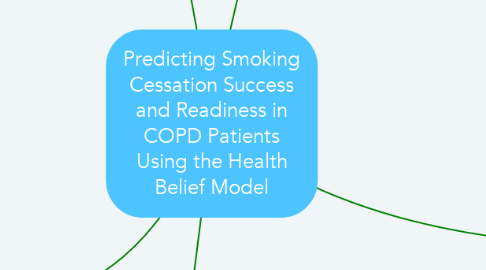
1. Perceived barriers to smoking cessation
1.1. Include
1.1.1. Time
1.1.2. Physical and/or psychological dependence
1.1.2.1. Leading to
1.1.2.1.1. Difficulty quitting
1.1.2.1.2. Adverse withdrawal symptoms
1.1.2.1.3. Discomfort
1.1.3. Availability of resources
1.1.3.1. Such as
1.1.3.1.1. Nicotine replacement therapy
1.1.3.1.2. Support groups
1.1.3.1.3. Psychologists/psychiatrists
1.1.4. Previous failures in smoking cessation
1.1.5. Witnessed failures in smoking cessation
1.2. Leading to
2. Perceived self-efficacy in smoking cessation
2.1. Influenced by
2.1.1. Previous attempts to quit smoking
2.1.1.1. Including
2.1.1.1.1. Successes and failures
2.1.1.1.2. Challenges faced in quitting
2.1.1.1.3. Side effects faced
2.1.2. Support system
2.1.2.1. Including
2.1.2.1.1. Family
2.1.2.1.2. Friends
2.1.2.1.3. Primary Care provider
2.1.2.1.4. Support Group
2.1.2.1.5. Therapy
2.1.3. Resources available
2.1.3.1. Including
2.1.3.1.1. Primary Care Provider
2.1.3.1.2. Therapy/psychologist
2.1.3.1.3. Support Groups
2.1.3.1.4. Smoking cessation aids
2.1.4. Health Education
2.1.4.1. Given by
2.1.4.1.1. Health care providers
2.1.4.1.2. Support Groups
2.1.4.1.3. Peer groups
2.1.4.1.4. Role models
2.1.4.1.5. Schools
3. Perceived threat of smoking to health
3.1. Influenced by
3.1.1. Presence of smoker in household
3.1.1.1. Impacts
3.1.1.1.1. Exposure to smoking at a younger age
3.1.1.1.2. Values and knowledge surrounding smoking by a role model or peers
3.1.2. Education and exposure
3.1.2.1. leading to
3.1.2.1.1. Contemplation phase of behavior
3.1.2.1.2. Preparation for changing behavior
4. Perceived benefits of smoking cessation
4.1. Impacted by
4.1.1. Education
4.1.1.1. Suggesting
4.1.1.1.1. Benefit from early education
4.1.1.1.2. Benefit from early detection and intervention
4.1.2. Life event by self or other
4.1.2.1. Causing
4.1.2.1.1. Smoking relapse
4.1.2.1.2. Scare causing desire for smoking cessation
4.1.3. Exposure to disease or illness
4.1.3.1. Leading to
4.1.3.1.1. Perceived benefits from smoking cessation
4.1.4. Decrease in physical functioning
4.1.4.1. Leading to
4.1.4.1.1. Perceived benefits of smoking cessation
4.1.5. Psychosocial situations
4.1.5.1. Such as
4.1.5.1.1. Nicotine induced relaxation
4.1.5.1.2. Anxiety, depression
4.1.5.1.3. Self medication
5. Perceived risks of smoking
5.1. Determined by
5.1.1. Home exposure
5.1.2. Peer group exposure
5.1.3. Education
5.1.3.1. By
5.1.3.1.1. Primary care providers
5.1.3.1.2. Schools
5.1.3.1.3. Parents/family
5.1.3.1.4. Role models
5.1.3.1.5. Peers
5.1.4. Previous encounters
5.1.4.1. Such as
5.1.4.1.1. Smoking related illnesses/conditions
5.1.4.1.2. Family member smoking
5.1.4.1.3. Witnessing a seeming lack of adverse effects in peers or family members
5.1.4.1.4. Commercials and social media
